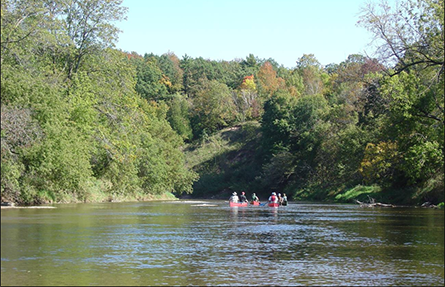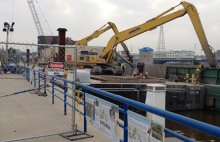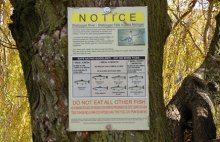Sheboygan River and Harbor site
Hazardous Waste Site | Sheboygan, WI | 1870s to Present
What Happened?
Beginning as early as the 1870s, various industrial facilities released PCBs, heavy metals, and PAHs to the Sheboygan River and the surrounding area. EPA designated the lower 14 miles of the Sheboygan River a Superfund site in 1986.
EPA worked together with the Wisconsin Department of Natural Resources and some of the potentially responsible parties to clean up the contaminants. NOAA provided technical expertise to assist the effort. Cleanup activities took decades to complete, concluding in 2013.
NOAA and other trustees also assessed injuries to natural resources from contaminants at the site and identified restoration projects that would compensate the public for these injuries.
What Were the Impacts?
Since 1979, high PCB levels have prompted the State of Wisconsin to advise against consumption of all resident fish species, and recommend limited consumption of other species, between Sheboygan Falls and the mouth of the Sheboygan River. Ecological and biological injuries also occurred due to the adverse effects of contaminants on sediment, soil, invertebrates, fish, reptiles, amphibians, birds, and mammals in the vicinity.
What’s Happening Now
On March 30, 2018, the Sheboygan River and Harbor federal and state natural resource Trustees released a Final Damage Assessment and Restoration Plan (PDF, 130 pages). The draft of the plan was released for public comment in December 2017.
On April 17, 2018, the United States District Court for the Eastern District of Wisconsin entered the final consent decrees announcing three settlements, with Tecumseh Products Co., Thomas Industries, Inc., and Wisconsin Public Service Corp., in excess of $4.5 million for natural resource damages at the Sheboygan River and Harbor Superfund site. The settlements include two projects that protect 324 acres of unique habitat and improve public recreational access to natural resources.
- Acquisition of property on Willow Creek, high quality habitat supporting trout and salmon, with no current conservation protection.
- Acquisition of Amsterdam Dunes, a rare Great Lakes coastal dune and swale habitat, with only minimal conservation protection. Preservation will benefit unique plant and animal species, and the local community, expanding recreational access to Lake Michigan.
The settlements also provide funding for future restoration projects at these and other sites. NOAA and the co-trustees will jointly manage the settlement funds to implement projects described in the restoration plan.
In April 2020, the Trustees released a draft supplement to their March 2018 Restoration Plan for public comment. In July 2020, The Trustees approved $801,000 to fund five habitat restoration and recreation projects in areas impacted by hazardous waste there. The projects were included in a final supplement to the 2018 plan, The projects will help restore wetlands, river and upland habitats, and enhance recreational uses within the Sheboygan River Basin.
"People have largely avoided the Sheboygan River for decades because of the contamination. Restoring the river returns a sense of pride and ownership in the community. People are again appreciating the river and the wildlife it supports."
Deb Beyer
Natural Resources Educator, University of Wisconsin
Contacts
Terry S. Heatlie, PWS
NOAA Restoration Center
Ann Arbor, MI
terry.heatlie@noaa.gov
(734) 741-2211









